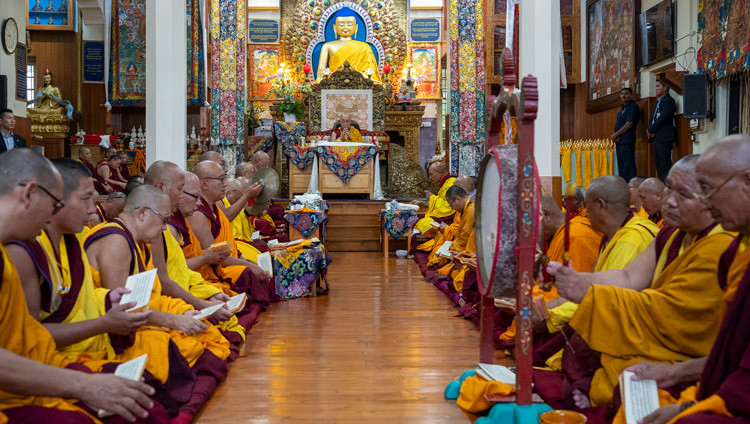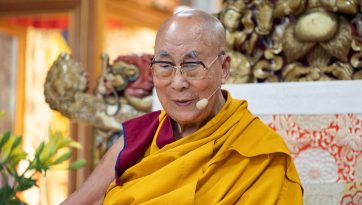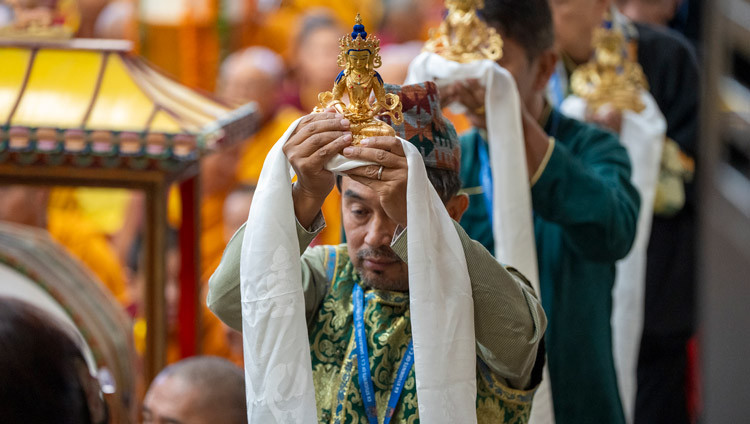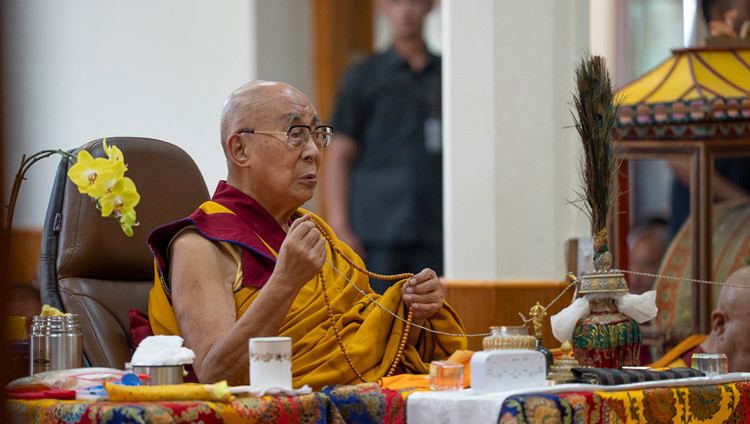Teachings for Young Tibetans – first day
Thekchen Chöling, Dharamsala, HP, India – As His Holiness the Dalai Lama drove through the courtyard to the Tsuglagkhang, the Main Tibetan Temple, this morning, costumed dancers whirled in welcome. At the foot of the temple two students stepped forward to offer the traditional ‘Chema Changphu’. His Holiness took a pinch of one and dipped his finger in the other. He surveyed the crowd, many of whom held up white silk scarves by way of welcome, smiled and waved.
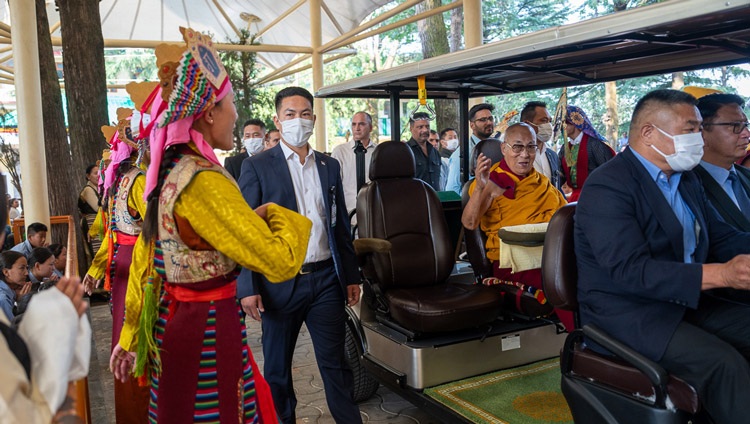
His Holiness the Dalai Lama riding in a golf cart through the courtyard of the Main Tibetan Templ as costumed dancers perform a welcome dance on his way to give the first day of teaching for young Tibetans in Dharamsala, HP, India on June 3, 2024. Photo by Tenzin Choejor
A crowd of about 5500 had gathered in the temple and the courtyard. They included 1800 foreigners from 57 countries. However, the main focus of today’s teachings were young Tibetans. There were 900 TCV students from class nine and above, 161 college students, 40 young local Tibetans and 80 members of the Introduction to Buddhism Class.
Once His Holiness had taken his seat on the throne, children from Gopalpur TCV School recited ‘A Clear Mirror: The Compendium of Awareness’, a fundamental text, from memory. It opens with a verse of homage to Manjushri, then proceeds to explain the ways of knowing. Next, the children recited the single verse prayer for His Holiness’s long life followed by the Praise to Manjushri that begins:
Obeisance to my Guru and Protector, Manjushri,
Who holds to his heart a scriptural text symbolic of his seeing all things as they are,
Whose intelligence shines forth as the sun, unclouded by delusions or traces of ignorance
Who teaches in sixty ways, with the loving compassion of a father for his only son, all creatures caught in the prison of cyclic existence, confused in the darkness of their ignorance, overwhelmed by their suffering.
This they followed with verses of salutation from the ‘Ornament of Clear Realization’:
Through the knowledge-of-all, the Disciples seeking peace are led to true peace.
Through the knowledge-of-the-path, those intending to benefit wandering beings, fulfil the aims of the world.
Being perfectly endowed with the omniscient mind, the sages give various teachings with all kinds of aspects:
I bow down to the mother of all Buddhas together with the communities of Hearers and Bodhisattvas.
And the verse of homage from Nagarjuna’s ‘Fundamental Wisdom’:
I prostrate to the perfect Buddha,
The best of teachers, who taught that
That which is dependently arisen is
Without cessation, without arising;
Without annihilation, without permanence;
Without coming; without going;
Without distinction, without identity
And peaceful—free from fabrications.
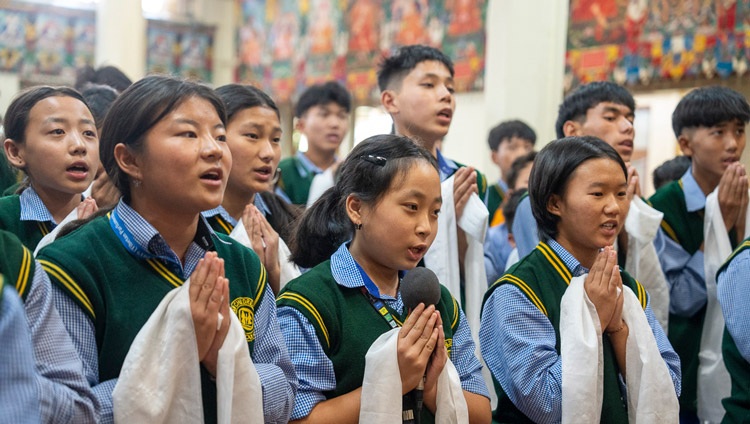
Children from Gopalpur TCV School reciting ‘A Clear Mirror: The Compendium of Awareness’ at the start of the first day of His Holiness the Dalai Lama’s teachings for young Tibetans at the Main Tibetan Temple in Dharamsala, HP, India on June 3, 2024. Photo by Tenzin Choejor
His Holiness asked if, in addition to the ‘The Compendium of Awareness’, the children had memorized the ‘Versified Compendium of Logic and Reasoning’, both texts having be written by Akya Yongdzin, Yangchen Gawai Lodro. Their teacher told him they were working on it.
“I memorized both these texts when I was a small child,” His Holiness declared. “It’s part of our approach to study that we memorize the text, without necessarily understanding what it’s about, and receive comprehensive explanations of it afterwards.
“We are refugees, living in exile, and we can see that in general people of the world are not very interested in studying the great treatises by masters of the past, but we Tibetans have kept this tradition alive for more than a thousand years. The Chinese and perhaps the Vietnamese studied the texts but didn’t immerse themselves in logic as we did.
“As I mentioned, I memorized both ‘The Compendium of Awareness’and the ‘Versified Compendium of Logic and Reasoning’ when I was young and recited them before both my tutors. I learned about definitions and synonyms and also how we have to employ logic.”
His Holiness gave a transmission of the ‘Praise to Manjushri’ and led the congregation in reciting Om ara patsa na dhi.
“As I’ve told you before, when I was very small, maybe three years old, I visited Kumbum Monastery near to where I lived. There I saw and heard very young monks reciting Om ara patsa na dhi. I naturally joined in. That was the first mantra I recited and I’ve relied on it ever since.
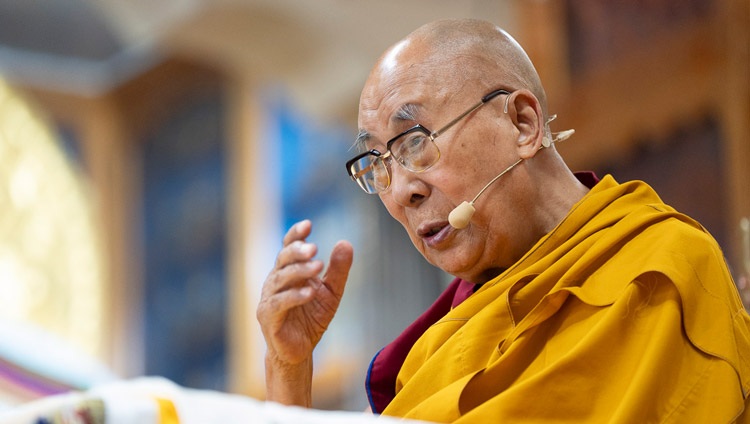
His Holiness the Dalai Lama addressing the congregation on the first day of his teachings for young Tibetans at the Main Tibetan Temple in Dharamsala, HP, India on June 3, 2024. Photo by Tenzin Choejor
“In Tibet, someone told a tutor to a previous Dalai Lama, maybe it was Phurba Chok, that he was an incarnation of Manjushri. ‘I don’t know about that’ he replied, but perhaps we could say I’m Manjushri’s neighbour. Perhaps I could say that too. Not only have I studied the four schools of Buddhist thought, I’ve had the opportunity to acquaint myself with other religious traditions. Moreover, I’m blessed with the four types of wisdom: great wisdom, deep wisdom, quick wisdom and clear wisdom.
“Tibetans are quite bright and have a natural sense of right and wrong, but you schoolchildren would do well to develop these four kinds of wisdom and the abiliity to think logically. So, you should not only recite mantras, you should also learn how to analyze things.
“As far as keeping Buddhism alive is concerned, I’ve done my best and will continue to do so. Meanwhile, I feel the Buddha has taken care of me.”
His Holiness took up the text of the ‘Key to the Middle Way’, a book he composed himself. Noting a reference to mistaken consciousness as a source of suffering, he emphasized that it is not enough to read about such things, we have to learn to recognise them in ourselves and transform them.
He read steadily through pages that touched on the importance of dealing with the mind, briefly explained the Four Seals, outlined the Four Schools of Tenets, highlighted the difference between provisory and definitive teachings, and accentuated the Four Reliances.
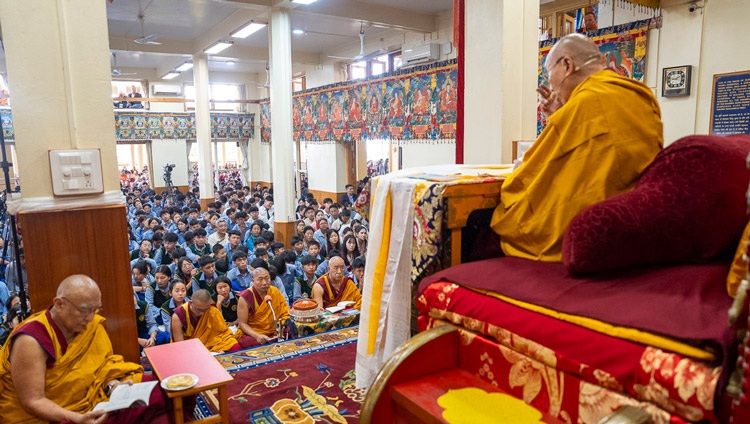
His Holiness the Dalai Lama reading from the text ‘Key to the Middle Way’, a book he composed himself, on the first day of teachings for young Tibetans at the Main Tibetan Temple in Dharamsala, HP, India on June 3, 2024. Photo by Tenzin Choejor
With regard to the question, what is emptiness? His Holiness advised that we need to develop a conceptual understanding of emptiness through reasoning; we need to recognize the object of negation. We also need to appreciate that emptiness means emptiness of inherent existence. Ignorance of the emptiness of inherent existence is the root cause of all bad consciousnesses and the suffering that is a consequence of them.
He mentioned the Two Truths as well as the Middle Way between existence and non-existence, the crucial point being that emptiness doesn’t deny the possibility of valid conventional truths, laws, or sciences.
His Holiness stopped reading when he reached this verse from Nagarjuna’s ‘Precious Garland’:
A person is not earth, not water,
Not fire, not air and not space
Not consciousness, and not all them.
What else is a person?
He remarked that with regard to conventional phenomenon, what we are saying is that when we scrutinize things, we cannot find them. However, without critical analysis, examining what is good or bad, whether we’re dealing with ourselves or others, whether we or they are young or old—all these qualities exist and can be found. He clarified that things exist by way of mere appearance, but when examined under critical analysis they fall apart and are found not actually to exist the way they appear.

